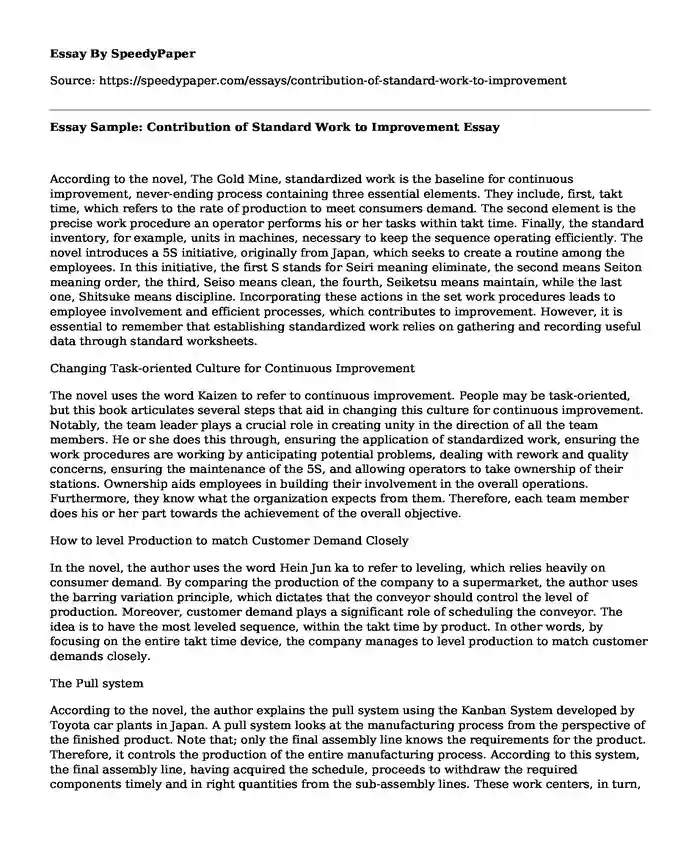
| Type of paper: | Essay |
| Categories: | Human resources Productivity |
| Pages: | 3 |
| Wordcount: | 604 words |
According to the novel, The Gold Mine, standardized work is the baseline for continuous improvement, never-ending process containing three essential elements. They include, first, takt time, which refers to the rate of production to meet consumers demand. The second element is the precise work procedure an operator performs his or her tasks within takt time. Finally, the standard inventory, for example, units in machines, necessary to keep the sequence operating efficiently. The novel introduces a 5S initiative, originally from Japan, which seeks to create a routine among the employees. In this initiative, the first S stands for Seiri meaning eliminate, the second means Seiton meaning order, the third, Seiso means clean, the fourth, Seiketsu means maintain, while the last one, Shitsuke means discipline. Incorporating these actions in the set work procedures leads to employee involvement and efficient processes, which contributes to improvement. However, it is essential to remember that establishing standardized work relies on gathering and recording useful data through standard worksheets.
Changing Task-oriented Culture for Continuous Improvement
The novel uses the word Kaizen to refer to continuous improvement. People may be task-oriented, but this book articulates several steps that aid in changing this culture for continuous improvement. Notably, the team leader plays a crucial role in creating unity in the direction of all the team members. He or she does this through, ensuring the application of standardized work, ensuring the work procedures are working by anticipating potential problems, dealing with rework and quality concerns, ensuring the maintenance of the 5S, and allowing operators to take ownership of their stations. Ownership aids employees in building their involvement in the overall operations. Furthermore, they know what the organization expects from them. Therefore, each team member does his or her part towards the achievement of the overall objective.
How to level Production to match Customer Demand Closely
In the novel, the author uses the word Hein Jun ka to refer to leveling, which relies heavily on consumer demand. By comparing the production of the company to a supermarket, the author uses the barring variation principle, which dictates that the conveyor should control the level of production. Moreover, customer demand plays a significant role of scheduling the conveyor. The idea is to have the most leveled sequence, within the takt time by product. In other words, by focusing on the entire takt time device, the company manages to level production to match customer demands closely.
The Pull system
According to the novel, the author explains the pull system using the Kanban System developed by Toyota car plants in Japan. A pull system looks at the manufacturing process from the perspective of the finished product. Note that; only the final assembly line knows the requirements for the product. Therefore, it controls the production of the entire manufacturing process. According to this system, the final assembly line, having acquired the schedule, proceeds to withdraw the required components timely and in right quantities from the sub-assembly lines. These work centers, in turn, produce in lots sufficient to replace the depleted numbers. This initiates a chain of reaction with workstations withdrawing required components only when necessary and in set quantities.
The significance of Gemba
According to the author, Gemba is the Japanese name for the place in this case inside the manufacturing plant where the production happens. The Gemba attitude reflects the notion that the reports, ideas, and measures transmitted to the management are only an abstraction of what is happening to create value. Therefore, being at the place where operations take place plays a significant role in increasing the identification of real problems first hand, and finding solutions immediately.
Cite this page
Essay Sample: Contribution of Standard Work to Improvement. (2019, Aug 30). Retrieved from https://speedypaper.net/essays/contribution-of-standard-work-to-improvement
Request Removal
If you are the original author of this essay and no longer wish to have it published on the SpeedyPaper website, please click below to request its removal:
- Essay Example on Internships and Why Are They Significant
- Essay Sample to Check: CSR Business Strategy
- Research Paper Sample: Psoriasis and Systematic Lupus Erythematosus
- Essay Sample Analyzing The Great Gatsby by Scott Fitzgerald
- Free Essay Answers: Should Sports Impose a Minimum Eligibility Requirement Based On Age?
- Free Essay Dedicated to Public Policy Ethics
- Essay Sample on Curbing Misinterpretation of Data
Popular categories




